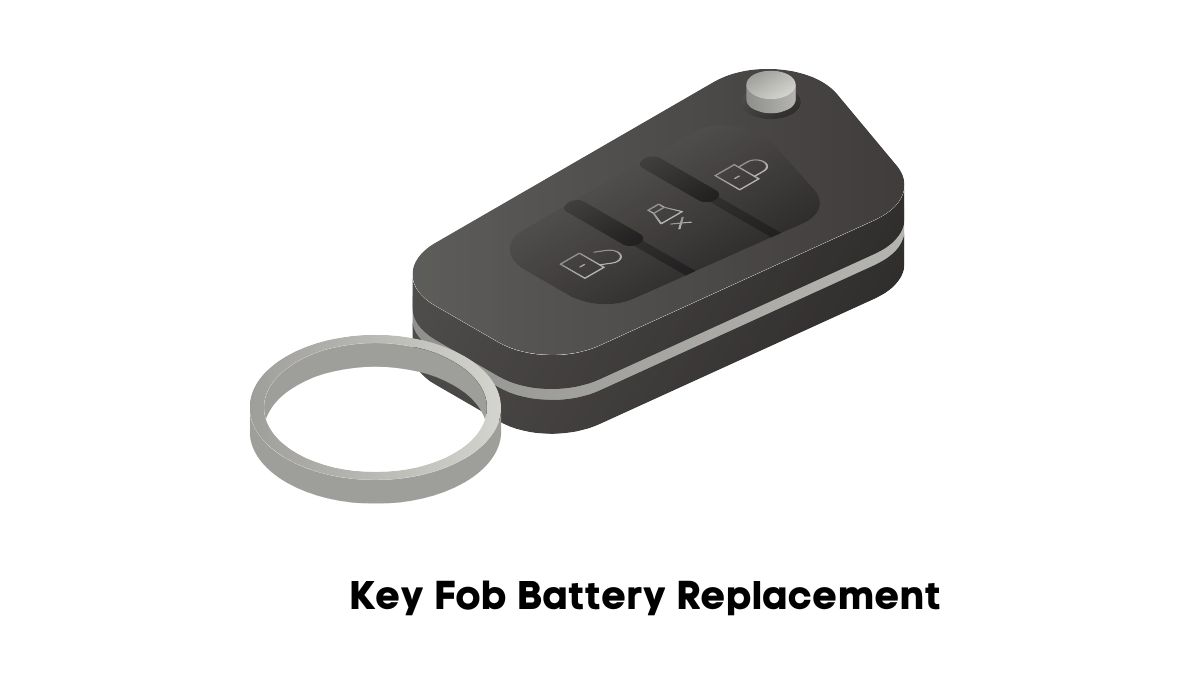Fight the temptation to tamper with the key fob until you read the manual. You have two significant concerns:
- Rechargeable Batteries
Some key fobs use rechargeable batteries, which may come as a surprise because many drivers have never seen or heard of them. One paper in Info Mat notes that rechargeable batteries became widespread decades ago because of the popularity of portable electronic devices.
However, many automobile companies don’t see the point in making rechargeable batteries for key fobs because button cell batteries are inexpensive. That said, several brands have introduced the concept in the last few years.
You can’t replace most rechargeable batteries. You need a brand-new key fob. Therefore, opening the fob is a waste of time.
- Warranty
Even if the battery is replaceable, some manufacturers prohibit consumers from opening the key fob. They expect drivers to return the fob with its depleted battery to the dealership.
Opening the fob will void the warranty.
Tools Required For Key Fob Battery Replacement

The only tool of note is a screwdriver. Key fobs have tiny screws. Therefore, you should look for a micro screwdriver. Although you can probably get by with a knife, particularly one with a sharp point.
Any tool that matches the screw size and fits into the fob’s seam or indentation will do. The only threat to the fob is your hand. You need a steady hand to gently pry the fob open without damaging it.
This assumes that you can open the key fob in the first place. Some fobs are glued shut. They won’t open unless you force them apart. If they survive, you must glue them back together. You should also forget about using your warranty to repair or replace the key. Usually, you void the warranty once you force the glued fob open.
Common Types Of Key Fob Battery Compartments And Access Methods
Key fobs are simplistic devices, at least in terms of their physical appearance. You can open them in one of three ways:
- Screw
Some fobs are screwed shut. You can’t access the battery’s compartment without identifying and removing the screw. This means buying a screwdriver with a head small enough to fit the screw. You can’t force these fobs open without removing the screw. Doing so will break them.
- Seam
Most fobs consist of two halves that a manufacturer connects. They are designed to snap together. If you take a closer look, you will see the seam running along the halfway mark. You can push a flathead screwdriver into that seam to pry the two halves apart.
You’re more likely to break fobs with seams because some drivers apply too much pressure. They don’t realize that many key fobs have plastic bodies. You can minimize the risk by prying the fob open at multiple points along the seam.
- Indentation
Some manufacturers include an indentation specifically designed to accommodate sharp tools, such as knives and screwdrivers. Push the tool into the indentation and force the fob open.
According to Polycase, you can order a customized enclosure for your key fob. Some customized enclosures require unique tools and methods to open.
Step-By-Step Guide For Replacing A Key Fob Battery
If the manual permits you to open the key fob, use the following steps to replace the battery:
- Your initial step will depend on the fob type. Some fobs have a key that slides back into the fob or to the side. Do what it takes to get the key blade out of the way. That includes pulling it out (if that is an option).
- If the fob has a screw, find a tool that fits the screw. These screws are usually quite small. Use the appropriate screwdriver to remove it. Proceed slowly and gently. You don’t want to strip the screw.
- If you can’t see any screws, look for a seam at the point where the two halves of the fob combine. Some fobs offer indentations or slots. Work the screwdriver into this opening and force the fob open. Do this gently. Some key fobs are plastic. You may snap the body if you apply too much force.
- The battery is the first thing you will see. You don’t have to search for it. The cell looks like a small coin or button. You can either pry it out directly or remove the clips holding the battery in place.
- Take note of the battery’s orientation. Try to remember the direction in which it entered the key fob. The fob won’t work if you position the new battery the wrong way.
- Insert the new battery. Make sure the battery is secure before you move on.
- Snap the two sections of the fob together. Usually, you hear a snap.
- Insert the screw and tighten it.
- Test the key fob. Point at the car and press the buttons. Do the doors open? Does the vehicle start? Does the alarm deactivate? If the key fob doesn’t work, you have a bad battery, the wrong battery type, the wrong battery specs, a defective key fob, etc.
Precautions To Take Before Replacing A Key Fob Battery
Key fob batteries are not particularly difficult to replace. You pull the two halves apart, remove the old battery and insert the new battery before pushing the case back together. Admittedly, many people break the fob while prying the case open.
This is usually accidental. Some of them apply too much pressure. Others force a large screwdriver into a tiny seam, which ultimately shatters the case. You also have those who force a knife or screwdriver into the wrong section.
This is why the manual is so important. It will instruct you on the best way to open the case. At the very least, it will bring the screw’s presence to your awareness. A key fob’s screw is small enough that many people miss it, which is a recipe for disaster.
The battery itself won’t present a challenge. You won’t cause any harm by inserting the battery the wrong way. The coin is unlikely to fit. And even if it does, the fob won’t work, which should alert you to your mistake.
Tips For Ensuring A Secure Fit Of The New Battery In The Key Fob
CR2032 is the recommended size for key fobs. But you can’t go wrong if you match the replacement battery’s attributes to the dimensions in the manual. If the key fob has an old battery, you’re in luck. Take it out and look at the back. The label will show you the correct replacement to install.
Don’t forget that manufacturers hire personnel to answer questions such as this one. If you contact the customer support staff associated with your vehicle’s brand, they will provide an accurate recommendation once you submit the car’s VIN.
Key fobs are usually programmed with a specific VIN in mind. The VIN will tell them the type of key fob you have, which, in turn, allows the manufacturer to recommend a suitable battery type and size.
Testing The Key Fob After Battery Replacement To Ensure Proper Functionality

You test new batteries by determining whether the key fob functions as the manual promises. Does it open the door when you press the button? Is this response immediate, or do you observe delays?
Do the doors open the moment you press the button, or do you hold the button down for several seconds to get results? Can you start the car? Test every function mentioned in the manual. If they all work in a timely manner, the new battery is okay. If you notice glitches, don’t try to reprogram the key. Take the fob to the dealership.
Different Battery Types Compatible With Key Fobs

Common key fob batteries include CR2032, CR2025, CR2016, and CR2450. You can choose between lithium, alkaline, and silver oxide batteries. Lithium-ion is the most popular because of its impressive lifespan and ability to function optimally in low temperatures.
But alkaline batteries have a firm hold on the market because they are cheaper. Laypeople rarely mention silver oxide even though it has a stable voltage output.
The technicians you consult are unlikely to obsess over the battery type. Instead, they will emphasize the size and specs. If you’re lucky, the manual will tell you the proper battery type to use.
Proper Handling And Disposal Of Old Key Fob Batteries
You can’t just throw old batteries in the trash. First of all, old batteries are a fire hazard. Secondly, they contain toxins that threaten the environment. The experts at the United States Environmental Protection Agency have found that coin batteries (the kind you find in key fobs and watches) contain various heavy metals, including mercury, cadmium, and nickel. So how do you dispose of them? Your options include the following:
1). Send The Batteries to a recycling plant.
If you have one in your area, give them a call and ask whether they accept key fob batteries. If they do, place the batteries in plastic bags. You can also wrap them in electrical tape before leaving the batteries in the designated location.
Recycling firms will label the bins that accept lithium batteries. Placing key fob batteries in a general recycling bin is a bad idea.
2). Mail The Batteries To A Recycling Plant
What if the recycling plant in your area doesn’t accept coin batteries? Though Co has recommended some mail-order services. Look for firms in your region that can pick up and deliver old batteries to the recycling plant.
3). Send The Batteries To A Retailer
Where did you buy the batteries? Nidirect recommends returning them to the source. Many retailers accept old batteries. Recycling plants collect these batteries from retailers. You should also look for recycling points in public spaces such as schools.
Some communities are littered with recycling bins and points. It is a simple matter of finding the bin that accepts lithium batteries.

